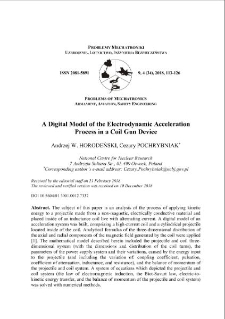Nasza Biblioteka Cyfrowa udostępnia 1 868 obiektów cyfrowych
Obiekt
Tytuł: A Digital Model of the Electrodynamic Acceleration Process in a Coil Gun Device ; A Digital Model of the Electrodynamic Acceleration Process in a Coil Gun Device
Tytuł odmienny:
Cyfrowy model procesu elektrodynamicznej akceleracji w urządzeniu typu Coil Gun ; Cyfrowy model procesu elektrodynamicznej akceleracji w urządzeniu typu Coil Gun
Współtwórca:
Cezary POCHRYBNIAK ; Cezary POCHRYBNIAK
Abstrakt:
The subject of this paper is an analysis of the process of applying kinetic energy to a projectile made from a non-magnetic, electrically conductive material and placed inside of an inductance coil live with alternating current. A digital model of an acceleration system was built, comprising a high-current coil and a cylindrical projectile located inside of the coil. Analytical formulas of the three-dimensional distribution of the axial and radial components of the magnetic field generated by the coil were applied [1]. The mathematical model described herein included the projectile and coil three-dimensional system (with the dimensions and distribution of the coil turns), the parameters of the power supply system and their variations, caused by the energy input to the projectile (and including the variation of: coupling coefficient, pulsation, coefficient of attenuation, inductance, and resistance), and the balance of momentum of the projectile and coil system. A system of equations which depicted the projectile and coil system (the law of electromagnetic induction, the Biot-Savart law, electric-to-kinetic energy transfer, and the balance of momentum of the projectile and coil system) was solved with numerical methods. The conclusions relevant to the design and technology of an ICG (Inductance Coil Gun), derived from the foregoing numerical analysis, were experimentally verified. Initial calculations were completed to optimise the acceleration process. The acceleration efficiency in a cascade of 10 coils was calculated.
;
The subject of this paper is an analysis of the process of applying kinetic energy to a projectile made from a non-magnetic, electrically conductive material and placed inside of an inductance coil live with alternating current. A digital model of an acceleration system was built, comprising a high-current coil and a cylindrical projectile located inside of the coil. Analytical formulas of the three-dimensional distribution of the axial and radial components of the magnetic field generated by the coil were applied [1]. The mathematical model described herein included the projectile and coil three-dimensional system (with the dimensions and distribution of the coil turns), the parameters of the power supply system and their variations, caused by the energy input to the projectile (and including the variation of: coupling coefficient, pulsation, coefficient of attenuation, inductance, and resistance), and the balance of momentum of the projectile and coil system. A system of equations which depicted the projectile and coil system (the law of electromagnetic induction, the Biot-Savart law, electric-to-kinetic energy transfer, and the balance of momentum of the projectile and coil system) was solved with numerical methods. The conclusions relevant to the design and technology of an ICG (Inductance Coil Gun), derived from the foregoing numerical analysis, were experimentally verified. Initial calculations were completed to optimise the acceleration process. The acceleration efficiency in a cascade of 10 coils was calculated.
Miejsce wydania:
Warszawa
;
Warszawa
Wydawca:
Wojskowa Akademia Techniczna ; Wojskowa Akademia Techniczna
Data utworzenia:
Data złożenia:
Data wydania:
Rozmiar:
Identyfikator:
oai:ribes-88.man.poznan.pl:2530
Sygnatura:
DOI 10.5604/01.3001.0012.7337 ; DOI 10.5604/01.3001.0012.7337
ISSN elektroniczny:
ISSN drukowany:
Język:
Właściciel praw:
Wojskowa Akademia Techniczna ; Wojskowa Akademia Techniczna
Strona początkowa:
Strona końcowa:
Tom:
Słowa kluczowe:
Coil Gun, acceleration, electromagnetic force, coil, propulsion, electromagnetism ; Coil Gun, acceleration, electromagnetic force, coil, propulsion, electromagnetism
Kolekcje, do których przypisany jest obiekt:
Data ostatniej modyfikacji:
18 wrz 2025
Data dodania obiektu:
18 wrz 2025
Liczba wyświetleń treści obiektu:
0
Wszystkie dostępne wersje tego obiektu:
https://ribes-88.man.poznan.pl/publication/2838
Wyświetl opis w formacie RDF:
Wyświetl opis w formacie OAI-PMH:
| Nazwa wydania | Data |
|---|---|
| A Digital Model of the Electrodynamic Acceleration Process in a Coil Gun Device | 18 wrz 2025 |
Obiekty Podobne
Andrzej HORODEŃSKI Cezary POCHRYBNIAK, Kamil NAMYŚLAK

